ASUS GeForce GTX 780 Ti DirectCU II OC Review
Published by Christian Ney on 07.01.14Page:
 ASUS has finally released its custom designed GTX 780 Ti graphics card and today we have a chance to check out the ASUS GTX 780 Ti DirectCU II OC version, which features the new version of the DirectCU II cooling, factory overclock as well as a custom design with a VRM part which is much better than the one on the reference graphics card. In a couple of next pages, we will try to check out if the new ASUS custom designed graphics card justifies the change from the reference design and has what it takes to cope with similar designs from competition
ASUS has finally released its custom designed GTX 780 Ti graphics card and today we have a chance to check out the ASUS GTX 780 Ti DirectCU II OC version, which features the new version of the DirectCU II cooling, factory overclock as well as a custom design with a VRM part which is much better than the one on the reference graphics card. In a couple of next pages, we will try to check out if the new ASUS custom designed graphics card justifies the change from the reference design and has what it takes to cope with similar designs from competition
 Article in English Article in English |
 Artikel in Deutsch Artikel in Deutsch |
 Article en français Article en français |
 Articolo in italiano Articolo in italiano |
Presentation
ASUS has finally launched a custom version based on Nvidia's GTX 780 Ti design and although a bit late to the party, the new ASUS GTX 780 Ti DirectCU II OC graphics card features a custom design PCB with much better and beefed up VRM, DirectCU II cooler and a decent factory overclock. The new GTX 780 Ti DirectCU II OC shares a lot of similarities with the ASUS GTX 780 DirectCU II series and in our book, that is definitely a good thing as why change something that is already good.
As you can see from the GPU-Z screenshot below, ASUS decided to use an average factory-overclock on the new GTX 780 Ti DirectCU II OC. While the standard reference GTX 780 Ti GPU is set to work at 875MHz for the base GPU and 928MHz for the GPU Boost clock, the new ASUS GTX 780 Ti DirectCU II OC works at 954 MHz for the base clock and 1'020 MHz for the Boost GPU clock.
Unfortunately, no factory overclocking was done on the 3GB of GDDR5 memory that remains at recommended 1'750 MHz (7'000 MHz effective).
While the typical Boost clock is set at 1'020 MHz, the maximum Boost of 1'097 (1.200v) MHz was achieved quite easily and the GTX 780 Ti DirectCU II OC held that clock most of the load time due to good custom cooler as well as good TDP target (Nvidia's Boost technology being based on both temperature and power on this card, the latter being predominant). The GPU Max. Boost clock only dropped in Furmark down to 954 MHz at 1.000v because of the power target and even lower past 80°C. It also did not held in some games where it dropped from 1'097 to 1'084, but that is not a big issue considering it actually stayed well above the advertised typical Boost clock.

Specifications
| GBT 780 Ti GHz | ASUS 780 Ti DC2OC | GeForce GTX 780 Ti | GeForce GTX 780 | |
| Chip | GK110-425-B1 | GK110-425-B1 | GK110-425-B1 | GK110-300-A1 |
| Process | 28 nm | 28 nm | 28 nm | 28 nm |
| Transistors | 7.10 billion | 7.10 billion | 7.10 billion | 7.10 billion |
| GPU clock | 1'085 MHz | 954 MHz | 875 MHz | 863 MHz |
| GPU Boost clock | 1'150 MHz | 1'020 MHz | 928 MHz | 900 MHz |
| Memory GDDR5 | 3'072 MB | 3'072 MB | 3'072 MB | 3'072 MB |
| Memory clock | 1'750 (7'000) MHz | 1'750 (7'000) MHz | 1'750 (7'000) MHz | 1'502 (6'008) MHz |
| Memory interface | 384 Bit | 384 Bit | 384 Bit | 384 Bit |
| Memory bandwidth | 336'000 MB/s | 336'000 MB/s | 336'000 MB/s | 288'400 MB/s |
| Shader Cores | 2'880 (15 SMX) | 2'880 (15 SMX) | 2'880 (15 SMX) | 2'304 (12 SMX) |
| TMUs | 240 | 240 | 240 | 192 |
| ROPs | 48 | 48 | 48 | 48 |
| TDP | xxx Watt | xxx Watt | 250 Watt | 250 Watt |
| PCB Type | Custom Design | Custom Design | Reference Design | Reference Design |
| Lenght (PCB - Total) | 26.9 - 28.8 cm | 27.2 - 28.7 cm | 27.0 - 27.0 cm | 27.0 - 27.0 cm |
| Height (PCB - Total) | 11.0 - 12.9 cm | 13.9 - 14.7 cm | 11.0 - 11.0 cm | 11.0 - 11.0 cm |
| Slots | 2 | 2 | 2 | 2 |
| Cooler | WindForce 3X 450W | DirectCU II | NVIDIA Reference | NVIDIA Reference |
| Launch Price | $XXX | $XXX | $699 | $649 |
| Navigate through the articles | |
 Gigabyte GeForce GTX 780 Ti GHz Edition Review
Gigabyte GeForce GTX 780 Ti GHz Edition Review |
ASUS GeForce GTX 780 Poseidon Platinum (air) Review
 |
|
|



